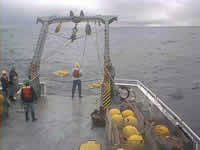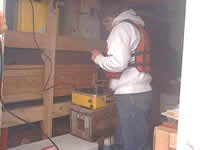| |

Crew of the Wecoma recovering the moorings
which have been anchored to the bottom for a year recording current
information.
Technicians using the acoustics
hydrophone to "talk" with the mooring and release it. |
|
Teacher Logbook - R/V Wecoma
Missy Holzer 's Sealog:
Day 2
We know we've made it only because the GPS has told us so. There are
no trusty landmarks in the open ocean to lead us to Axial Volcano, only
the expertise of the Captain and crew in their navigational skills. Now
onto the tasks of the day. Dr. Baker posted a schedule for the day which
included the recovery of moorings that were set out a year ago, a couple
of CTD casts, and possibly a tow.
As soon as we arrived at our location it was time to find the moorings.
The moorings are anchored to the ocean floor and ascend up the water column
about 300 meters. How are the moorings going to be brought up to the surface
since they can't be seen from the ship? Through the use of acoustics they
can be released from their anchors. One of the scientists uses a hydrophone
to communicate with the release mechanism at a specific frequency, and
then the mooring ascends to the surface with the help of a number of floats
placed strategically along the mooring line. Finding the mooring is fairly
easy once it has reached the surface since the floats are bright yellow
and a red flag is attached to the top of the mooring.
Whether it's in the design of a mooring or in the design of the research
protocal, the creativity in oceanographic research is astounding, and
is needed in order to accomplish the research goals desired by the scientist.
In order to identify the location of hydrothermal vent activity, sampling
must be done at various levels in the water column. Temperature, pressure,
light scattering, and particulate matter are sampled by placing sensors
and samplers at various locations on the mooring. These instruments can
then be programmed to take readings at various times as determined by
the scientist. The moorings we recovered< today have been in their locations
for approximately one year, and while on board preliminary anlaysis will
be done on the data they have collected.
Come back online tomorrow to find out about the status of the CTD cast...
|

